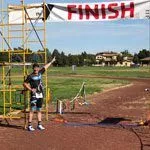Understanding Your 80/20 Endurance Run Plan
by Matt Fitzgerald
Be sure to read Intensity Guidelines for Running and Understanding Your TrainingPeaks Structured Workout Plan after reading this article.
A training plan is only as good as its execution. Even the best training plan won’t help you much if you don’t understand it. This article offers guidelines and tips to help you get the most out of the 80/20 Run plans.
Anatomy of a Workout
Each workout has three basic elements. The first two are duration/distance (how long the workout is) and intensity (how fast the workout is). The third is structure, which is how the workout is divided into segments of various lengths and intensities. The workout descriptions you see in the training schedules provide information about duration/distance, intensity, and structure in a condensed format.
Let’s look at one example:
Critical Velocity Intervals Run
5:00 in Zone 1
10:00 in Zone 2
5 x 4:00 @ CV/2:00 in Zone 1
15:00 in Zone 1
We chose this example because it has a fairly complex structure. Nevertheless, it’s not at all difficult to decode and follow. The workout has three segments: a warm-up, an interval set, and a cool-down.
“5:00 in Zone 1, 10:00 in Zone 2” is the warm-up segment. You’ll execute this part by jogging easily for 5 minutes at Zone 1 intensity and then running for 10 minutes at Zone 2 intensity.
“5 x (4:00 @ CV/2:00 in Zone 1)” is the interval segment. What these instructions are telling you to do is run for 4 minutes at CV, which, as the pre-activity comments area of this workout explains, stands for Critical Velocity, or the fastest pace you could sustain for 30 minutes, equal to the low end of Zone 4. You then slow down and jog for 2 minutes in Zone 1, and repeat this sequence a total of five times.
“15:00 in Zone 1” is the cool-down segment.
You’ll execute this by jogging easily for 15 minutes at Zone 1 intensity. There is an almost infinite variety of workout structures, but if you understand how to interpret and apply the example we just covered, you can do the same with any other workout.
Note that you have the flexibility to perform the workout at any point within the zone. For example, if the workout segment calls for Zone 1, and your Zone 1 heart rate is 115 to 129 bpm, you can perform the segment anywhere within that range. Continually performing workout segments at the upper end of a zone does not always lead to superior results. Sometimes appropriate recovery requires performing Zone 1 and 2 segments at the low end of the range. It is also best to perform moderate and high intervals consistently rather than intensely. Performing a set of 5 intervals at mid-Zone 3 is preferable to performing each of 5 intervals at a different point in Zone 3. Only when you are well-recovered and can perform intervals consistently is it recommended to execute the segment at the high end of the zone.
Getting to Know Your Zones
Perhaps the trickiest part of executing the workouts that are prescribed in a training plan is running at the right intensity in each segment. You will find complete guidelines for using our seven-zone intensity scale in our Intensity Guidelines. But simply reading these guidelines alone won’t enable you to fully master the skill of running in the right zones. A certain amount of experience is also required.
Don’t worry: It doesn’t take long to develop a feel for the various zones, so that, for example, when you start a 3-minute interval in Zone 3, you are able to settle into the right effort level even before your device confirms that you’re in the correct zone. Here are some specific tips for mastering each individual zone:
Zone 1
Zone 1 is a very low intensity. Staying within it usually requires that you actively hold yourself back to a pace that’s slower than your natural running pace. The common exception is when a Zone 1 recovery jog follows a tiring high-intensity effort. The important thing to understand is that it’s almost impossible to go too slow when you’re aiming for Zone 1, whereas it’s very easy and all too common to go too fast.
Zone 2
Zone 2 is fairly broad. You might wonder, “Where exactly within this zone should I be?” As a general rule, we encourage runners to go by feel. If you feel strong, run near the top end of Zone 2. If you feel tired or sluggish, go ahead and allow yourself to run near the bottom end.
Zone X
Zone X is given a letter name instead of a numerical name because it is generally avoided in training. It’s more of a gap between Zones 2 and 3 than a zone unto itself. Zone X represents the “moderate-intensity rut” that most runners get stuck in without realizing it before they adopt the 80/20 method and learn to slow down in their easy runs and long runs. However, Zone X does overlap with race intensity for many runners at the half-marathon and marathon distance. For this reason, many of our 80/20 Run plans include Steady State Runs, Half-Marathon Pace Runs, and/or Marathon Pace Runs that target Zone X. This zone is also targeted briefly in some Fartlek Runs and Progression Runs.
Zone 3
Zone 3 corresponds to lactate threshold intensity. Thinking in “threshold” terms can help you find this zone and stay in it by feel. The feeling of running in Zone 3 is often described as “comfortably hard,” or as the fastest speed that still feels relaxed. When you perform a Zone 3 effort, imagine there’s a cliff edge in front of you that represents the feeling of strain that accompanies faster speeds. Always stay one or two steps back from this precipice when training in Zone 3.
Zone Y
Like Zone X, Zone Y is more of a gap between zones than a one unto itself. It’s a little too fast for threshold workouts, which target Zone 3, and a little too slow for high-intensity interval workouts, which offer more fitness bang for your workout buck when done in Zones 4 and 5.
Zone 4
Mastering this zone is a matter of connecting the pace, power, and/or heart rate numbers that define the zone with what it feels like to run at that pace, power, or heart rate, so that you are able to reliably start each Zone 4 effort at the right intensity. If you mess it up the first few times, either going too slow or too fast, don’t sweat it. In fact, getting it wrong today is the best way to get it right tomorrow.
Zone 5
Zone 5 is almost always used in interval workouts, including Hill Repetitions Runs. This intensity zone ranges from the highest speed you can sustain for a few minutes all the way to a full sprint. So how fast should you actually run Zone 5 efforts? Tailor your pace to the specific format of the workout. The rule of thumb here is to run closer to the bottom end of Zone 5 when these efforts are longer and closer to the top end when the intervals are shorter. For example, if a workout asks you to run a bunch of 1-minute intervals in Zone 5, you’ll want to control your pace so that you are able to run all of the intervals at the same speed without slowing down. But if a workout prescribes a set of 20-second intervals, you’ll want to run them as relaxed sprints.
When using heart rate to measure intensity, you’ll soon discover that your BMP takes 1 to 2 minutes to “catch up.” As a result, you’ll often not reach the heart rate target during very brief Zone 4 or 5 intervals. Pace and Power are more reliable methods to measure those high intensities. If you prefer to train by heart rate, you can mitigate this lag issue by using the 80/20 Run and Bike Zones Garmin App, which allows you to have real-time HR and your custom 80/20 pace or power zones displayed on your device at the same time.
Why Zones X and Y?
You may wonder why a seven-zone intensity scale such as ours tops out at Zone 5. The reason is that in the original version of the scale, Zone X and Zone Y were not explicitly named. Instead these zones existed only as gaps between Zones 2 and 3 and between Zones 3 and 4, respectively. The first gap was created to ensure that low-intensity exercise efforts did not accidentally bleed into moderate intensity and the second to encourage athletes to commit to either moderate or high intensity. Nevertheless, many athletes found the gaps confusing, so we modified the 80/20 intensity scale in a manner that eliminates gaps and the confusion they cause while preserving the distinction between untargeted zones (X and Y) and targeted zones (1-5).
Cross-training
Although there are no formally scheduled cross-training sessions in the runs plans, you have a standing option to replace any Recovery Run or Foundation Run with a nonimpact cardio alternative of equal duration and intensity. You will see periodic reminders of this sprinkled throughout each plan.
So, when should you cross-train and when should you run? There are two competing, but equally valid, truths to consider when deciding whether to run or to cross-train. On the one hand, the more you run, the more you’ll improve as a runner. The principle of specificity teaches us that if you run instead of cross-training each time you see a Recovery Run or Foundation run on your schedule, your running performance will increase more than if you do the opposite. On the other hand, above a certain level, the more you run, the more likely it is that you will develop an impact-related overuse injury such as runner’s knee. So, if you’re injury prone or concerned about injury, you may be better off doing some or all of your Recovery Runs and Foundation Runs in a nonimpact cardio exercise modality such as bicycling.
There are two basic approaches to replacing runs with cross-training: the programmatic approach and the as-needed approach. In the programmatic approach, you replace certain runs with cross-training sessions routinely. For example, you might replace your first Foundation Run of each week with an elliptical workout. In the as-needed approach, you replace runs with cross-training only when soreness or fatigue from prior running makes running again seem inadvisable. Note that these two approaches are not mutually exclusive, and indeed you should cross-train instead of running anytime it seems risky to run, regardless of whether you also practice the programmatic approach. Finding the right balance for you may require some trial and error (See the section The Importance of Listening to Your Body below).
The best cross-training activities are those that are most similar to running without the impact element. Pool running, antigravity treadmill running, indoor and outdoor cycling, elliptical running, outdoor elliptical biking, steep uphill treadmill walking, indoor and outdoor cross-country skiing, inline skating, and steep uphill treadmill walking have all been used successfully. Strength training is a completely different sort of cross-training that we strongly recommend but as a complement to aerobic cross-training rather than a substitute for it. See Incorporating Strength Training to Your Plan for ideas on how to incorporate strength training into your plan.
Note that effective 80/20 training requires that you spend 80 percent of your combined aerobic training, encompassing running and cross-training, at low intensity. In the case of our 80/20 Run plans, this means all of your cross-training sessions need to be done in Zones 1 and 2.
Perfection is Overrated
While it’s important to execute workouts as they were intended to be done, it is not necessary that you execute every perfectly, and you shouldn’t beat yourself up when a given is not done to the letter. If the 10-mile run on your schedule for today ends up being a 9.9-mile, no big deal.
There’s a well-known story about a legendary running coach who always had his athletes run 187-meter hill repetitions. Another coach who admired this legendary coach emailed him to inquire about this very precise distance. “Why 187 meters?” he asked, assuming there must be some deep physiological rationale for it. But the legendary coach came back with this answer, “Why 187 meters? Because that’s how long the hill closest to our training camp is.”
Keep this story in mind as you can execute your 80/20 Run plans. As with horseshoes and hand grenades, close is good enough.
The Importance of Listening to Your Body
There are some times when executing the workouts in your training plan to the very letter is a bad idea. For example, if you get three intervals into a nine-interval workout and you feel absolutely terrible, you should probably stop, or replace the remaining intervals with an easy jog. (A helpful guideline to follow is this: If your pace for a given interval is more than 3% slower than it was in the previous interval, terminate the interval set and complete the remaining time in Zone 1 or 2.) Similarly, if you wake up one morning with a really sore foot that hurts even to walk on, you should not run that day.
A training plan is really an attempt to predict the future. The many workouts that comprise a training plan represent what you should do if everything goes perfectly-that is, if there are no days when you feel really lousy or have an alarming sore spot. But things seldom go perfectly all the way through a training program. It’s important that you listen to your body at every step of the process and make adjustments as necessary based on what your body is telling you.
Glossary of Workout Codes
| Code | sport | Name | Description |
|---|---|---|---|
| CA | Cycling | Accelerations Ride | Developed originally as a run workout by influential French exercise physiologist Veronique Billat, Accelerations Rides combine the unique physical challenge of riding at every intensity between a cruise and a full sprint with a unique and valuable pacing challenge.
Correct execution of the two accelerations in this workout entails accelerating continuously and gradually from Zone 2 to the top of Zone 5. The most common mistake is speeding up too quickly and thus running out of "gears" before the end, so guard against this. |
| CCP | Cycling | Critical Power Ride | Critical Power Rides feature longer intervals at an intensity that walks the line between moderate and high. They are designed to enable athletes to maintain a stable metabolic state at higher intensities.
Critical Power (CP) is the highest intensity a cyclist can sustain for 30 minutes, which for most falls at the low end of Zone 4. Try to maintain a steady level of output from the start of the first CP interval to the end of the last interval in this and other Critical Power Rides. Also pay attention to your output in the Zone 1 recovery segments. If you find yourself slowing down in these recoveries as the workout progresses, you might be going too hard in the CP segments. |
| CDI | Cycling | Descending Intervals Ride | Developed by scientists at the University of Udine in Italy, Descending Intervals are proven to increase the amount of time an athlete is able to spend above 90% of VO2max intensity within a single session. This makes the workout a potent way to boost aerobic capacity (aka VO2max).
The heart of the workout is a set of five efforts of decreasing length that target Maximal Aerobic Power (MAP), which is the highest output a cyclist can sustain for about 6 minutes and falls at the low end of Zone 5. Each MAP effort is followed by a Zone 1 active recovery that's two-thirds the duration of the preceding effort. Athletes have a natural tendency to adjust their effort to the duration of a segment, automatically doing shorter segments at a higher effort level than longer ones. In Descending Intervals Rides like this one, though, you should do each Zone 5 segment at the same effort level even though they get shorter. |
| CSP | Cycling | Speed Play Ride | Speed Play Rides are essentially casual interval rides. They serve to deliver modest doses of high-intensity cycling and fit well in base training, recovery weeks, and pre-race taper periods.
This particular Speed Play Ride hits every zone from 1 to 4. Frequent speed changes make it fun but also challenging to pace. Do the best you can to nail each segment and trust that you'll get better with practice. Note that the recovery segments between faster efforts in this Speed Play Ride target Zone 2 rather than Zone 1, as in standard interval workouts. In other words, the "easy" parts aren't quite as easy, which contributes to the fitness-boosting effect of the ride. |
| CSS | Cycling | Steady State Ride | Steady State Rides target Zone X, a zone that is generally avoided in the 80/20 system but is good to spend SOME time in, as doing so builds a bridge between extensive endurance (the ability to ride far) and intensive endurance (the ability to ride fast without fatiguing).
The Zone X segment in this ride should be completed at an effort you feel you could sustain for 2 hours, which falls somewhere between Olympic-distance and half-iron race effort for most athletes. |
| CVI | Cycling | Variable-Intensity Intervals Ride | Variable-Intensity Interval Rides feature an unusual two-step interval format that is proven to enable athletes to spend more time at or near VO2max intensity than they do in traditional, single-pace intervals. The result is bigger gains in aerobic capacity/VO2max.
The first 30 seconds of each Variable-Intensity Interval are done at Maximal Aerobic Power (MAP), which is the highest output you could sustain for about 6 minutes, and the next 45 seconds are run at Functional Threshold Power (FTP), which aligns with the top end of Zone 3. These two steps are repeated four times before you dial back to Zone 1 to recover. Variable-Intensity Intervals are almost as challenging mentally as they are physically. Effective execution does not require that you complete each and every segment at just the right intensity, but it does require that you make your best effort to do so, and this effort demands steady focus. |
| LIC | Cycling | Lactate Intervals Ride | Lactate Intervals Rides are designed to boost aerobic capacity (aka VO2max), which is the most important physiological underpinning of cycling performance. This particular format was developed by exercise scientists at Inland Norway University as a way to increase the amount of time an athlete is able to spend near VO2max intensity within a single session without becoming exhausted.
Lactate Intervals target Zone 4, which is fairly broad. You'll get the most benefit if you aim for an effort you could sustain for 15 minutes in race conditions, which will put you close to the middle of the zone. Because both the intervals and the recoveries are so short in this workout, pacing can be tricky. Don't worry--you'll get the hang of it as you go. |
| OUC | Cycling | Over/Under Intervals Ride | Over/Under Intervals Rides feature intervals in which the intensity fluctuates between slightly above and slightly below the lactate threshold (LT). The harder segments target Zone Y, which occupies the small space between Zone 3 and Zone 4, while the easier segments target Zone 3, whose upper limit aligns with LT.
Like Tempo Rides and other workouts that directly target LT, Over/Under Intervals develop the ability to ride relaxed and efficiently at moderate intensity, but their variable-intensity format offers the additional benefit of teaching the body to recover from a harder effort while still riding somewhat aggressively. In doing this or any Over/Under Intervals Ride, focus on oscillating gently around the high end of Zone 3, going from just below it in the Zone 3 segments to just above it in the Zone Y segments. |
| ER | Running | Endurance Run | As their name suggests, Endurance Runs serve to develop the basic physiological and psychological ingredients of endurance, including fat-burning capacity and mental focus.
Whether you use pace, heart rate, or power as your primary intensity metric, you should always regulate your Endurance Runs by perceived effort as well, in such a way that you COULD speed up slightly at the end of the run if you chose to. Note that heart rate tends to rise over the course of an Endurance Run and may exceed Zone 2 toward the end even if you maintain a steady pace. This phenomenon, known as cardiac drift, is caused by fatigue-related efficiency loss and dehydration. When it happens, you do NOT need to slow down to lower your heart rate unless your pace or power is also above the Zone 2 range. |
| LIR | Running | Lactate Intervals Run | Lactate Intervals Runs are designed to boost aerobic capacity (aka VO2max), which is the most important physiological underpinning of running performance. This particular format was developed by exercise scientists at Inland Norway University as a way to increase the amount of time an athlete is able to spend near VO2max intensity within a single session without becoming exhausted.
Lactate Intervals target Zone 4, which is fairly broad. You'll get the most benefit if you aim for a pace you could sustain for 15 minutes in race conditions, which will put you close to the middle of the zone. Because both the intervals and the recoveries are so short in this workout, pacing can be tricky. Don't worry--you'll get the hang of it as you go. |
| OUR | Running | Over/Under Intervals Run | Over/Under Intervals Runs feature intervals in which the intensity fluctuates between slightly above and slightly below the lactate threshold (LT). The harder segments target Zone Y, which occupies the small space between Zone 3 and Zone 4, while the easier segments target Zone 3, whose upper limit aligns with LT.
Like Tempo Runs and other runs that directly target LT, Over/Under Intervals develop the ability to run relaxed and efficiently at moderate speeds, but their variable-pace format offers the additional benefit of teaching the body to recover from a harder effort while still running somewhat aggressively. In doing this or any Over/Under Intervals Run, focus on oscillating gently around the high end of Zone 3, going from just below it in the Zone 3 segments to just above it in the Zone Y segments. |
| R5K | Running | 5K Pace Intervals Run | 5K Pace Intervals offer essential practice at race pace during 5K training but are also a useful fitness builder in training for shorter and longer events.
Although the 5K pace (5KP) intervals in this workout target Zone 4, your 5KP may fall outside this zone, so do your best to complete the intervals at a pace you could sustain for 5K in race conditions regardless of zone. Unlike most 80/20 workouts, this one is distance-based rather than time-based because its job is to give runners of all ability levels equal preparation for the 5K race distance. Any time associated with this session is a broad estimate. Note that the 0.1 km Zone 1 segment following each 5KP segment is actually intended as passive rest, so just walk for 100 meters. |
| R10K | Running | 10K Pace Intervals Run | 10K Pace Intervals offer essential practice at race pace during 10K training but are also a useful fitness builder in training for shorter and longer events.
Although the 10K pace (10KP) intervals in this workout target Zone 4, your 10KP may fall outside this zone, so do your best to complete the intervals at a pace you could sustain for 10K in race conditions regardless of zone. Unlike most 80/20 workouts, this one is distance-based rather than time-based because its job is to give runners of all ability levels equal preparation for the 10K race distance. Any time associated with this session is a broad estimate. Note that the 0.1 km Zone 1 segment following each 10KP segment is actually intended as passive rest, so just walk for 100 meters. |
| RA | Running | Accelerations Run | Developed by influential French exercise physiologist Veronique Billat, Accelerations Runs combine the unique physical challenge of running at every pace between a jog and a full sprint with a unique and valuable pacing challenge.
Correct execution of the two accelerations in this workout entails accelerating continuously and gradually from Zone 2 to the top of Zone 5. The most common mistake is speeding up too quickly and thus running out of "gears" before the end, so guard against this. Because each acceleration culminates in an all-out effort, you'll need to walk a but before you resume running. |
| RCV | Running | Critical Velocity Run | Critical Velocity Runs feature longer intervals at an intensity that rides the line between moderate and high. They are designed to enable runners to maintain a stable metabolic state at faster paces.
Critical Velocity (CV) is the fastest pace a runner can sustain for 30 minutes, which for most falls at the low end of Zone 4. CV is also slower than 5K race pace and faster than 10K race pace for most runners. Try to maintain a steady pace from the start of the first CV interval to the end of the last interval in this and other Critical Velocity Runs. Also pay attention to your pace in the Zone 1 recovery segments. If you find yourself slowing down in these as the workout progresses, you may be running the CV segments too fast. |
| RD | Running | Depletion Run | A Depletion Run is essentially an Endurance Run that is performed in a calorie-restricted state. Do this run on an empty stomach and consume only water and electrolytes during it--no calories.
Depriving your muscles of calories before and during a longer run, as Depletion Runs like this one require, offers two proven benefits. The best-known benefit is improvement in the ability of the muscles to burn fat during running. But Depletion Runs have also been shown to increase aerobic capacity (aka VO2max) more than regular long runs. Because Depletion Runs are meant to be done on an empty stomach, it's generally most convenient to do them first thing in the morning before breakfast. |
| RDI | Running | Descending Intervals Run | Developed by scientists at the University of Udine in Italy, Descending Intervals are proven to increase the amount of time an athlete is able to spend above 90% of VO2max intensity within a single session. This makes the workout a potent way to boost aerobic capacity (aka VO2max).
The heart of the workout is a set of five efforts of decreasing length that target Maximal Aerobic Speed (MAS), which is the fastest pace a runner can sustain for about 6 minutes and falls at the high end of Zone 4. Each MAS effort is followed by a Zone 1 active recovery that's two-thirds the duration of the preceding effort. Runners have a natural tendency to adjust their effort to the duration of a segment, automatically running shorter segments faster than longer ones. In Descending Intervals Runs like this one, though, you should run each Zone 4 segment at the same speed even though they get shorter. |
| RFR | Running | Fartlek Run | Fartlek Runs are essentially casual interval runs. Designed to deliver modest doses of faster running, they fit well in base training, recovery weeks, and pre-race taper periods.
"Fartlek" means "Speed Play" in Swedish. Bring a playful mindset to this run by relying more on perceived effort than on pace, heart rate, or power to regulate your effort level during the faster segments. Note that the recovery segments in this Fartlek Run target Zone 2 rather than Zone 1, as in most interval sessions. In other words, the "easy" parts aren't quite as easy, which contributes to the fitness-boosting effect of the run. |
| RHM | Running | Half-Marathon Pace Run | Half-Marathon Pace Runs offer essential practice at race pace during half-marathon training, but are also a useful fitness builder in training for shorter and longer events.
Although the half-marathon pace (HMP) segments in this run target Zone 3, your HMP may fall outside this range, so do your best to complete the segments at a pace you could sustain for a half marathon in race conditions regardless of zone. Unlike most 80/20 workouts, this one is distance-based rather than time-based because its job is to give runners of all ability levels equal preparation for the half-marathon race distance. Any time associated with this session is a broad estimate. Note that the 0.1 km Zone 1 segment following each HMP segment is actually intended as passive rest, so just walk for 100 meters. |
| RL | Running | Long Run | Long Runs are intended to develop the endurance required to "go the distance" on race day. For this reason they are always distance-based. Any time associated with this session is a broad estimate.
Whether you use pace, heart rate, or power as your primary intensity metric, you should always regulate your Long Runs by rate of perceived effort as well, distributing your energy in such a way that you COULD speed up slightly at the end of the run if you chose to. Note that heart rate tends to rise over the course of a Long Run and may exceed Zone 2 toward the end even if your pace is steady. This phenomenon, known as cardiac drift, is caused by fatigue-related efficiency loss and dehydration. When it happens, you do NOT need to slow down in order to lower your heart rate unless your pace or power is also above the Zone 2 range. |
| RLS | Running | Speed Intervals Run | Speed Intervals Runs will not make you a faster sprinter, but they will improve your running economy and your ability to resist fatigue at faster speeds. Studies have shown that even ultrarunners benefit from including some speed intervals in their training.
Speed Intervals are necessarily quite short. For this reason, you'll need to rely mainly in perceived effort to regulate your effort. Specifically, aim for a 9-out-of effort for the workout as a whole. It's a good idea to include some form drills in your warm-up before doing Speed Intervals. These will help you perform better and reduce the risk of muscle/tendon strains. Here are links to some suggested drills: A Skips B Skips High Knees Butt Kicks |
| RMP | Running | Marathon Pace Run | Marathon Pace Runs are intended to help runners become more efficient and comfortable at marathon pace (MP). They can also be used outside of marathon training to provide an endurance stimulus that's more challenging than a standard long run.
Complete the Marathon Pace segments of this run at a speed you could sustain for a full marathon in race conditions. If you're not sure what this is, just do your best and focus on using the run to get a clearer sense of your current marathon pace. Note that Marathon Pace Runs are always distance-based. Any time associated with this session is a broad estimate. |
| RP | Running | Progression Run | Similar to Fast Finish Runs, Progression Runs teach the body to run faster on tired legs. This particular run features a three-step progression that hits three moderate to high intensities: Lactate Threshold Pace, Critical Velocity, and Maximal Aerobic Speed.
Be careful to avoid speeding up too early in anticipation of the progression part of this Progression Run. Stay in Zone 2 until your device cues you to accelerate. The three moderate to high intensities targeted at the end of this Progression Run are not far apart from each other pace-wise. For this reason, you may find it challenging initially to hit each one individually without overshooting. That's okay; you'll get better with repetition. |
| RPI | Running | Progression Intervals Run | This workout format was developed by scientists at the University of Copenhagen in the 2010's and found to improve race performance in trained recreational runners. It features 1-minute intervals in which the first 30 seconds are completed in Zone 3, the next 20 seconds in Zone 4, and the last 10 second in Zone 5. You then go straight back to the top and complete the same sequence four times more for a total of five repetitions before easing down to Zone 1 for recovery.
Because they hit a variety of intensities without focusing on any single intensity, Progression Intervals work well as a general fitness developer during base building and as a fitness maintainer during recovery weeks and taper periods. Progression Intervals can be challenging to pace correctly because they require you to "shift gears" frequently. But it's a fun challenge if you embrace it, and you will get better with practice. |
| RSS | Running | Steady State Run | Steady State Runs target Zone X, a zone that is generally avoided in the 80/20 system but is good to spend SOME time in, as doing so builds a bridge between extensive endurance (the ability to run far) and intensive endurance (the ability to run fast without fatiguing).
The Zone X segment in this run should be completed at a pace you feel you could sustain for 2 hours, a number that falls between half-marathon and marathon pace for most runners. |
| RTT | Running | Relaxed Time Trial | A Relaxed Time Trial is a time trial that is run at 95% of race effort. These workouts serve to enhance goal-specific fitness and build confidence.
To execute this workout, simply add 5% to your 5K race goal time, calculate the corresponding pace, and complete the Relaxed Time Trial segment of the workout at that pace. For example, if your goal time is 20:00 (4:00/km), run the Relaxed Time Trial segment at 4:12/km. |
| RVI | Running | Variable-Intensity Intervals Run | Variable-Intensity Interval Runs feature an unusual two-step interval format that is proven to enable athletes to spend more time at or near VO2max intensity than they do in traditional, single-pace intervals. The result is bigger gains in aerobic capacity/VO2max.
The first 30 seconds of each Variable-Intensity Interval are run at Maximal Aerobic Speed (MAS), which is the fastest pace you could sustain for about 6 minutes, and the next 45 seconds are run at Lactate Threshold Pace, which aligns with the top end of Zone 3. These two steps are repeated four times before you dial back to Zone 1 to recover. Variable-Intensity Intervals are almost as challenging mentally as they are physically. Effective execution does not require that you run each and every segment at just the right intensity, but it does require that you make your best effort to do so, and this effort demands steady focus. |












































































